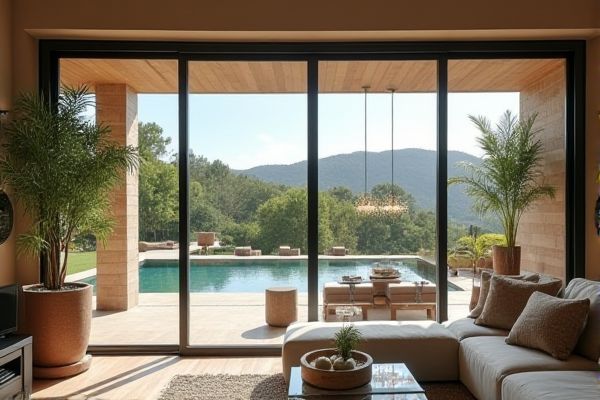
Retractable screens offer flexibility by extending only when needed, saving space and protecting the screen from damage when retracted, whereas fixed screens provide a permanent, sturdy setup ideal for consistent use and high-quality viewing experiences. Explore the rest of the article to determine which screen best suits your home or office needs.
Table of Comparison
| Feature | Retractable Screen | Fixed Screen |
|---|---|---|
| Installation | Complex; requires mounting mechanism | Simple; permanently installed |
| Space Efficiency | High; retracts when not in use | Low; always fixed in place |
| Durability | Moderate; moving parts prone to wear | High; solid construction |
| Cost | Higher initial cost | Lower cost |
| Maintenance | Regular upkeep needed | Minimal maintenance |
| Use Case | Ideal for flexible usage and aesthetic appeal | Best for permanent protection and insect control |
| Appearance | Sleek, less visible when retracted | Visible frame at all times |
Introduction to Retractable and Fixed Screens
Retractable screens offer flexibility by allowing users to extend or retract the screen as needed, providing convenience and space-saving benefits. Fixed screens, mounted permanently in place, deliver consistent stability and optimal tension for a clear, uninterrupted viewing experience. Choosing between retractable and fixed screens depends on the installation environment, usage frequency, and aesthetic preferences.
Key Differences: Retractable vs Fixed Screens
Retractable screens offer flexibility by allowing you to roll them up when not in use, saving space and protecting the screen from damage, while fixed screens provide a permanent, sturdy installation with consistent tension for optimal image quality. Retractable screens typically use a spring mechanism or manual pull-down system, making them ideal for multi-purpose rooms, whereas fixed screens are designed for dedicated viewing areas, offering a flat and wrinkle-free surface. Choosing between retractable and fixed screens depends on your space usage, desired portability, and the importance of long-term screen tension and durability.
Space-Saving Advantages of Retractable Screens
Retractable screens offer significant space-saving advantages by easily rolling up and out of sight when not in use, maximizing the available living area without permanent fixtures. Unlike fixed screens that occupy constant space and limit flexibility, retractable options can be customized to fit various window and door sizes, enhancing your home's functional design. This versatility makes retractable screens ideal for small spaces or multifunctional rooms where optimizing square footage is essential.
Durability and Maintenance Comparison
Retractable screens offer enhanced durability due to their ability to retract when not in use, protecting the mesh from weather damage and debris, which reduces wear and tear over time. Fixed screens, while structurally sturdy, are exposed constantly, making them more susceptible to damage and requiring frequent cleaning and repairs. Your choice depends on balancing long-term maintenance efforts with the need for permanent protection against insects and outdoor elements.
Aesthetics and Design Flexibility
Retractable screens offer superior design flexibility by seamlessly integrating into your space when not in use, maintaining a clean and minimalist aesthetic. Fixed screens provide a sturdy, permanent solution but can limit design options due to their constant presence and bulk. Choosing a retractable screen enhances your room's visual appeal by allowing you to preserve open, uncluttered spaces without sacrificing functionality.
Installation Process: Retractable vs Fixed Screens
Retractable screens typically require a more complex installation process involving precise mounting brackets and alignment to ensure smooth rolling functionality, often necessitating professional assistance. Fixed screens have a simpler installation, usually secured directly to window or door frames with screws or adhesive, allowing for quicker setup and lower installation costs. The choice impacts not only time and effort but also the flexibility of screen usage and maintenance requirements.
Cost Analysis: Which Option is More Affordable?
Fixed screens generally offer a more affordable initial cost compared to retractable screens due to simpler design and fewer mechanical components. Retractable screens require maintenance and replacement parts, which can increase long-term expenses, but their flexibility and space-saving features may justify the investment for your specific needs. Evaluating budget constraints and usage frequency will help determine which option aligns best with your affordability goals.
Best Use Cases for Retractable Screens
Retractable screens are ideal for versatile spaces where flexibility and aesthetics are key, such as home theaters, conference rooms, and multi-purpose living areas. Their ability to be hidden when not in use preserves room decor and prevents dust accumulation on the screen surface. These screens are particularly beneficial in environments requiring periodic use of the display without permanent installation.
Ideal Applications for Fixed Screens
Fixed screens excel in home theaters and dedicated media rooms, offering superior image quality and tensioned, flat surfaces for enhanced viewing experiences. They support larger screen sizes and higher-resolution projections, making them optimal for cinematic presentations and immersive gaming setups. Their rigid frames ensure consistent screen tension, reducing wrinkles and distortion for precise image reproduction.
Final Verdict: Choosing the Right Screen for Your Needs
Retractable screens offer flexibility and space-saving benefits, making them ideal for temporary use or areas with limited space. Fixed screens provide superior durability and consistently optimal tension, suited for permanent installations and frequent use. Selecting the right screen depends on your specific environment, usage frequency, and aesthetic preferences.
 homyna.com
homyna.com